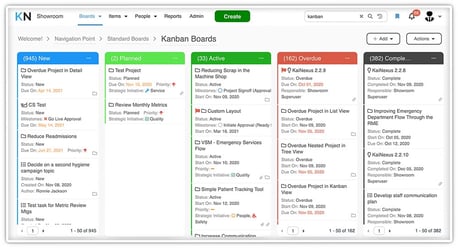
The Kanban technique started in the late 1940’s as Toyota looked to rethink its approach to manufacturing. The object was to reduce waste, improve efficiency and enable what’s come to be known as just-in-time manufacturing. Toyota’s workers displayed colorful Kanban cards to communicate to downstream workers that there was a demand for parts. (Kanban means “visual signal” or “shopkeepers card” in Japanese.) This visual management approach helped teams communicate instantly about what needed to be done and when.
Fast forward to today, and you’ll find that the Kanban approach has evolved to be useful for information workers and others in a variety of industries. The most common application is a physical board that shows work that is in the queue, in-progress, and completed. A physical Kanban board works great for small, centrally located teams with a limited number of projects in play at any one time. However, more complex groups which are distributed and organizations that want a centralized view of all improvement work have turned to digital Kanban boards instead. Here are a few benefits of the approach.
No Physical Limits
A Kanban board hung on a wall is only useful if you have access to the wall. These days many teams work from multiple locations, telecommuting is common, and people travel a lot. If you find yourself taking a photo of your Kanban board with your iPhone and emailing it to a remote co-worker, it is probably time to consider digital boards. Not only are they accessible to all team members, but they are also available 24x7, so that is new ideas come up or work gets completed after hours, employees can capture the information in real-time.
Of course, having the board present on a wall in a shared workspace is important for many organizations, as it keeps improvement front-of-mind and gives a location for daily huddles for on-site teams. These benefits are not lost with the implementation of digital boards; it's common for the digital board to be displayed on large screens hung in common areas just like their paper predecessors. The added benefit of making it digital means that during those huddles, you're able to drill down into the details of any improvement, log questions for the team, view accompanying documents and photographs, and update key metrics in real time.
More than a Snapshot
A physical Kanban board can be an excellent snapshot of the status of current work. However, it doesn’t tell you much about what came before and what might come after. Digital Kanban boards become a repository of information about every past project and a holding place for ideas for future initiatives. Employees can search previous projects to uncover best practices and avoid known pitfalls. They can also enter opportunities for improvement that might not be ready for action now but could lead to a project in the future.
Impact Measurement
Visualizing the current state of work is very useful, but when it comes to improvement-based projects, it is also essential to measure the impact of the improvement over time. Paper Kanban boards don’t really help you do this at all, but the best digital visual management solutions include impact measurement and reporting. Understanding the business results of each project can help make teams make better decisions about what process problems to tackle next. Impact measurement also helps justify continued investment in improvement work.
Success Broadcasting
Traditional Kanban boards are generally team-based and used by only those directly involved in the projects on the board. However, improvement experts have found that sharing the successes of each team helps drive deeper engagement and spread improvement across the organization. Digital boards provide a unified platform for broadcasting success beyond team boundaries.
Multiple Board Management
While front-line employees may interact with just one board, executive leaders need a much broader view of the work that is being done by people in every part of the organization. Walking around and looking at boards isn’t nearly as efficient as having a software platform that allows for the display of as many boards as necessary. Leaders can drill into specific projects, recognize potential roadblocks, and support the efforts of each department and team.
Alerts and Notifications
Physical Kanban boards are static. They just hang around waiting for someone to move the cards around or add more. Digital boards, on the other hand, provide active management through the use of notifications and alerts. People get email notifications when tasks are assigned when something is due, or when a deadline is missed. This helps employees and managers stay engaged in projects and see them through.
Strategic Alignment
Ideally, all improvement projects will be related to the strategic goals and objectives of the organization. Whether Hoshin Kanri planning or some other technique is used, close alignment between individual, team, department, and organizational goals is necessary for success. The best digital Kanban solutions allow targets to be cascaded from the c-suite to the front line, ensuring that everyone is rowing in the same direction and that projects are selected with due deliberation and consideration of the primary objectives.
If you are using physical Kanban boards and they are meeting your needs, that’s fantastic. If you are new to the approach or if you are finding that you aren’t getting the results you’d like to see, a move from the wall into the cloud might be the perfect next step.



Add a Comment